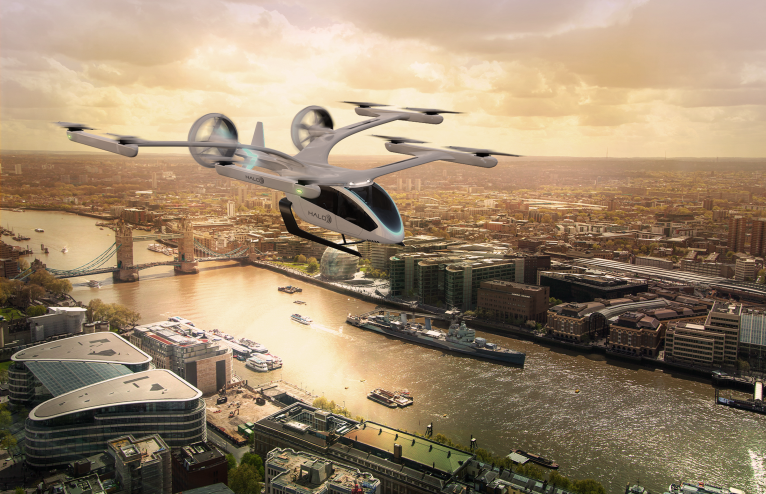
Flexjet’s Halo brand intends to operate Eve’s eVTOL aircraft and will need to identify and recruit pilots to fly it.
DUBLIN—Autonomous operations of electric-vertical-takeoff-and-landing (eVTOL) aircraft may eventually be permitted in regulation, acceptable to the public and attractive to potential passengers.
But in initial operations, these new aircraft will be flown by an onboard pilot. Who those people will be, and how they will be recruited, trained and retained were among the topics addressed during a panel discussion at Revolution.aero’s event here last week.
Each part of the discussion appears to depend, to some extent, on decisions made about the others, and in the current absence of even draft regulations, knowing where to start the conversation is challenging.
“I think we need to differentiate the stages of deployment,” said Christophe Lapierre, CEO of business aviation group Luxaviation’s advanced air mobility (AAM) division, Sigma Air Mobility. “There’s definitely a ramp-up phase where we all need to build the expertise and to create the trust ... in order to build the social acceptance and to be able to scale up later on. But [that means] having the right pilots with the right expertise.”
Exactly what expertise that may be is unclear. Panel moderator Adam Twidell, who heads up future-of-flight work in the Flexjet group, sought views from the audience about whether they would prefer heavy lift, rotary- or fixed-wing to fly within an eVTOL. Some suggested that helicopter pilots—with experience of confined-area and elevated takeoffs and landings—may have more directly applicable expertise, but the sector remains undecided.
“With the levels of autonomy that we’re talking about in these aircraft, these are different pilots that we’re going to be looking at: they’re not coming from traditional aviation strands and streams that we’ve seen so far,” said Julie Garland, founder and CEO of Avtrain, a firm that currently trains drone pilots but is looking to provide eVTOL pilot training. “We need to stop thinking, ‘Is it a helicopter pilot? Is it a fixed wing pilot?’ It’s a VTOL pilot.”
Identifying, training and certifying those pilots is not going to be something that happens overnight.
“People [are] looking a little bit too optimistically in saying that these are going to be some 18-year-olds that are going to fly the eVTOLs in 2025,” said Stella-Marissa Hughes, strategy lead in training services provider CAE’s AAM group. “Rulemaking takes five years. EASA [European Union Aviation Safety Agency] and the FAA are just starting to look at this from a pilot licensing [perspective]. They’ll want to see operations happen before they start looking at rulemaking around ab initio. [From] first start of commercial operations, you add an observation period to that, you add five years, that’s when you’re going to start having an ab initio rulemaking around that to start doing the training.”
With the number of different eVTOL platforms in development, and the number of aircraft each manufacturer says they have obtained sales commitments for, the demand for eVTOL pilots will place further pressure on an already overstretched training pipeline. Twidell notes that Flexjet, which currently has 1,200 pilots, is looking to recruit 350 more to work on its existing fleets in 2023. Finding large numbers of AAM pilots in that context will be challenging, but there may be new demographics to which the new sector could appeal.
“Less than 5% of the world’s pilots are females at this point in time. That’s a completely untapped resource that we can attract into this industry,” Garland said. Acknowledging that women tend to be primary caregivers and therefore reluctant to consider jobs that require extensive and unpredictable periods away from home, she argued that AAM may benefit due to the nature of its operations.
“The VTOL pilot is going to be able to pitch up for work in the morning and know that they’re going home that evening no matter what, because they’re not going to get stuck in a location a million miles from their house,” she said.
To attract new types of candidates, training needs to be competitively priced and streamlined compared to traditional flight schools. Training should be cheaper to deliver. This is because much of it will be carried out in simulators, since few of the in-development platforms will be available in dual-control trainer variants. Still, regulatory authorities will need to agree. And while the new career field may be attractive to those currently flying unmanned systems—“This is career progression for drone pilots,” Garland says—it will be difficult for the sector to offer pay and benefits packages sufficient to tempt experienced airline crewmembers. This all points to initial AAM services coming with a high seat ticket price.
“The team and the operation piece are costly,” Lapierre said. “And because we want to ensure this level of safety and to build the confidence, that will be costly to start. The price point will, at the beginning, be quite expensive.”





